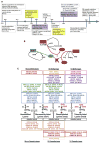Histone lysine methylation dynamics: establishment, regulation, and biological impact
- PMID: 23200123
- PMCID: PMC3861058
- DOI: 10.1016/j.molcel.2012.11.006
Histone lysine methylation dynamics: establishment, regulation, and biological impact
Abstract
Histone lysine methylation has emerged as a critical player in the regulation of gene expression, cell cycle, genome stability, and nuclear architecture. Over the past decade, a tremendous amount of progress has led to the characterization of methyl modifications and the lysine methyltransferases (KMTs) and lysine demethylases (KDMs) that regulate them. Here, we review the discovery and characterization of the KMTs and KDMs and the methyl modifications they regulate. We discuss the localization of the KMTs and KDMs as well as the distribution of lysine methylation throughout the genome. We highlight how these data have shaped our view of lysine methylation as a key determinant of complex chromatin states. Finally, we discuss the regulation of KMTs and KDMs by proteasomal degradation, posttranscriptional mechanisms, and metabolic status. We propose key questions for the field and highlight areas that we predict will yield exciting discoveries in the years to come.
Copyright © 2012 Elsevier Inc. All rights reserved.
Figures




References
-
- Allfrey VG, Mirsky AE. Structural Modifications of Histones and their Possible Role in the Regulation of RNA Synthesis. Science. 1964;144:559. - PubMed
-
- Aoto T, Saitoh N, Sakamoto Y, Watanabe S, Nakao M. Polycomb group protein-associated chromatin is reproduced in post-mitotic G1 phase and is required for S phase progression. J Biol Chem. 2008;283:18905–18915. - PubMed
-
- Baba A, Ohtake F, Okuno Y, Yokota K, Okada M, Imai Y, Ni M, Meyer CA, Igarashi K, Kanno J, et al. PKA-dependent regulation of the histone lysine demethylase complex PHF2-ARID5B. Nat Cell Biol. 2011;13:668–675. - PubMed
-
- Bannister AJ, Kouzarides T. Histone methylation: recognizing the methyl mark. Methods Enzymol. 2004;376:269–288. - PubMed
-
- Barski A, Cuddapah S, Cui K, Roh TY, Schones DE, Wang Z, Wei G, Chepelev I, Zhao K. High-resolution profiling of histone methylations in the human genome. Cell. 2007;129:823–837. - PubMed
Publication types
MeSH terms
Substances
Grants and funding
LinkOut - more resources
Full Text Sources
Other Literature Sources
Molecular Biology Databases
Miscellaneous

